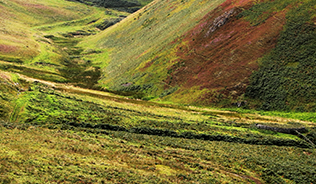The Lea Catchment is a tributary of the River Thames and London’s second river. Its source is in Luton before meandering its way through Hertfordshire and forming the boundary with Essex. Once the river flows under the M25 it changes in character from relatively natural to highly urbanised, with concrete banks. The Lea has a number of tributaries in London which are heavily urbanised and where persistent pollution flows into the river, making the London section of the Lea one of the most polluted stretches of river in the UK. Here Nathalie Gilbert explains how an innovative scheme between waterways charity Thames21 and Enfield Borough Council is tackling pollution across 473 hectares of urban catchment by creating new wetlands - even in tiny spaces - which has brought in new investment in an era of budget cuts.
Wetlands are often called ‘nature’s kidneys’ because they are great at removing sediment and pollutants from water, reducing the amount of harmful substances entering our waterways. The main way they do this is by slowing down the water flow as it passes through the wetland. Suspended sediment drops out of the water column to the wetland floor, or is trapped by roots and plants, leaving the water clearer. Many harmful environmental contaminants do not readily dissolve in water and adhere to the sediments. As the sediment settles out, these pollutants become bound up in the soil layer. Provided the sediments remain undisturbed, these contaminants remain locked away from harmful contact with plants and animals.
This ability to lock away pollution has been exploited in Enfield, where over the past four years nine constructed wetlands have been built. Three wetlands were retrofitted into small urban spaces, usually overlooked to effectively treat water pollution.
Slowing down the water is also important for improving water chemistry. It provides time for bacteria to naturally convert toxic nutrients into less harmful forms (e.g. the conversion of ammonia to nitrate). Nutrients from sewage effluent, agriculture and other sources are taken up by growing plants and soil microorganisms. Wetlands are so effective that they are increasingly being planted to function as wastewater treatment plants, usually at a fraction of the cost of traditional treatment facilities. Wetlands also have huge benefits for biodiversity and public recreation, becoming sites that people want to visit and protect, unlike usual water treatment plants. Through partnering with Thames21, over 13,000 Enfield residents have been engaged in these new wetlands sites.
Wetlands in small urban spaces
Wetlands constructed for waste water treatment (called constructed wetlands) usually require a lot of space to be effective and are therefore not often used in cities such as London, where land prices are high. However, Enfield Council and Thames21 were well aware that Enfield, like many urban sites in cities, was under high pressure from urban pollution issues and therefore in great need of water treatment solutions. Typical urban issues include high percentages of paved areas in catchments, which causes flooding due to rapid surface run off into rivers during rainfall. Precipitation rapidly carries oil and fuel residues and heavy metals from busy roads directly into rivers. Raw sewage from misconnected plumbing (http://www.connectright.org.uk/) and overwhelmed sewage networks also flows into rivers. High nutrient loads cause excessive plant growth (eutrophication) and fish deaths. All these issues were affecting the Enfield catchment.
How the Enfield wetlands were created
One wetland site, Firs Farm (site: 1.5 hectares), was formerly the boundary edge of extensive public playing fields, sadly under-used. Another is in an urban park (Pymmes Park, site: 0.5 hectares). The final wetland (site: 0.5 hectares) is situated in a small space in a typical suburban street along the former course of a small stream, the Glenbrook. At each site, badly polluted outfalls from the surface water drainage network enter at the top of a series of linked treatment basins. Cutting-edge technology was used to excavate the basins: 3D maps of the basin plans were uploaded directly to a smart digger which then precisely dug the holes. Volunteers assisted with planting each basin using native, shallow water species known to mop up pollution and to provide colour and interest for visitors and local wildlife. Species included common reed (Phragmites), marsh marigold (Caltha), water mint (Mentha) and purple loosestrife (Lythrum). Young plants arrived pre-grown on coir (coconut fibre) mats, which helped them establish, particularly in polluted environments.

Improvements in water quality
Building wetlands in small urban spaces is highly innovative, so to check they were functioning as intended and improving water quality, each site was monitored monthly or twice monthly for up to one year after construction. Water samples was taken from the inlet and outlet to investigate water quality improvements resulting from flow through the wetland. Samples were monitored for nutrients that are problematic in excess (ammonia, nitrate, phosphate and total nitrogen), and faecal coliform bacteria, an indicator of raw sewage.
Results were impressive and on a par with water quality improvements seen in much larger constructed wetlands. Ammonia, which is highly toxic in the aquatic environment, reduced by up to 69% between the inflow and outflow. Nitrate and phosphate, both nutrients that may cause eutrophication, reduced by up to 65% and 68% respectively. Faecal bacteria reduced by 78%, significantly reducing the risk of disease.
Water flowing out of the wetlands, although not pristine, posed significantly less risk to wildlife and water users than the water flowing in. However, wetlands are living ecosystems and they cannot treat all pollutants. Also, they can be overwhelmed if water is too polluted or in times of flood, so it is still important to protect local waterways by preventing harmful substances entering the environment in the first place.
The future
Sediment build up in wetlands will gradually reduce their functioning, so ongoing monitoring of their effectiveness is important. The next exciting phase in the story is just beginning in the form of real-time water quality monitoring. In conjunction with the Environment Agency, probes measuring water quality every 15 minutes have been fitted to the inflow and outflow of the Glenbrook wetland. These will provide even deeper insight into the functioning of these ground-breaking little wetlands. We are using the results from these studies to build them into a water quality model which we’ll use hand-in-hand with local communities to help increase understanding of these rivers and test scenarios and priorities for future wetland interventions. In future years we hope to introduce many more similar wetlands across the Lea Valley to improve the river’s health, which will benefit both wildlife and local communities.
Dr Nathalie Gilbert has been monitoring the performance of constructed wetlands at improving water quality on behalf of Thames21 for the past two years. She is also the INTCATCH Project Manager at Thames21. This multinational Horizon2020 project aims to develop innovative, user-friendly water monitoring tools to provide real-time data for SMART monitoring of freshwater bodies. She has a PhD and a Masters in Environmental Science from the University of East Anglia. (Nathalie.Gilbert@thames21.org.uk)
Funded by: Defra, the Environment Agency, Greater London Authority and Thames Water.
Header photo and in-article photo credit: Aimee Felus, Thames21.





